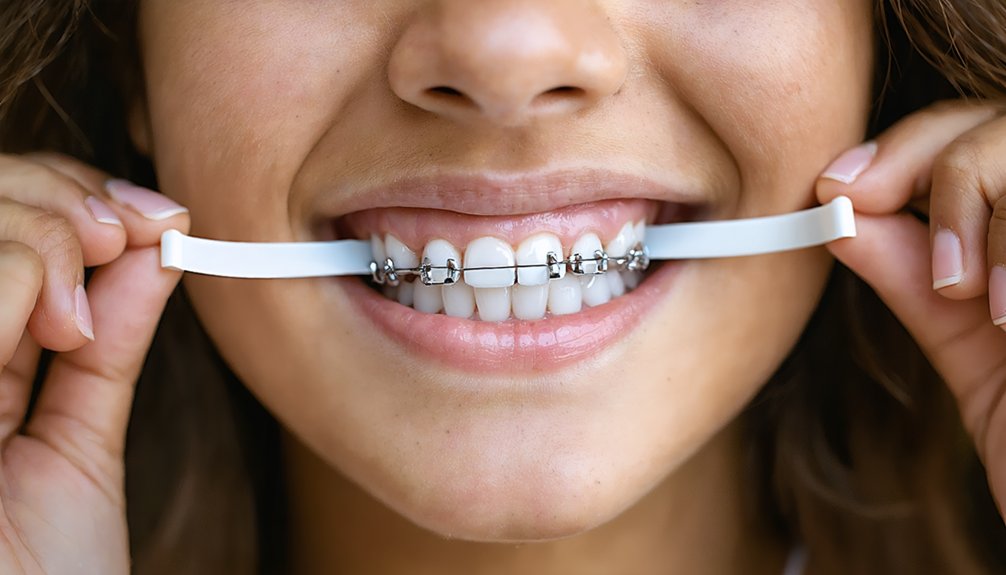Using whitening strips with braces isn’t recommended as they can’t reach beneath brackets, resulting in uneven coloration after your braces come off. Instead, focus on gentle alternatives like whitening toothpaste specifically formulated for orthodontic patients, maintain thorough oral hygiene, and avoid staining foods and drinks. You’ll achieve better results by waiting until after braces removal for professional whitening treatments. Understanding proper timing and safe methods will help you achieve the bright smile you’re seeking.
Key Takeaways
- Avoid using whitening strips with braces as they cannot reach beneath brackets, resulting in uneven tooth coloration after treatment.
- Wait until after braces removal for any whitening treatments, then allow 1-6 months before starting professional whitening procedures.
- Use gentle whitening toothpaste and proper brushing techniques during orthodontic treatment instead of whitening strips.
- Maintain good oral hygiene and minimize consumption of staining foods like coffee, wine, and tomato sauce.
- Schedule regular professional cleanings every 3-6 months to manage stains and maintain oral health during orthodontic treatment.
Understanding the Risks of Using Whitening Strips With Braces
While the desire to maintain a bright smile during orthodontic treatment is understandable, using whitening strips with braces poses several significant risks that require careful consideration.
The primary orthodontic considerations involve the whitening efficacy of these products when used with braces. You’ll find that whitening strips can’t reach beneath your brackets, resulting in uneven coloration once your braces are removed. Sensitive Dissolving Teeth Whitening Strips provide a gentler whitening option for those with braces.
Whitening strips fail to reach under brackets during orthodontic treatment, leading to noticeable spotting and discoloration after braces come off.
Additionally, the active ingredients in whitening products can interact with your braces’ metal components, potentially causing oxidation and discoloration. Using professional dental whitening is typically recommended after braces removal for more uniform results.
You’ll also need to be aware of increased tooth sensitivity due to hydrogen peroxide exposure, and the risk of gum irritation from chemical contact.
The combination of whitening agents and orthodontic appliances can compromise your dental health by potentially damaging tooth enamel through improper application or overuse.
Safe Alternatives for Teeth Whitening During Orthodontic Treatment
While you can’t use whitening strips during orthodontic treatment, you’ll find gentle whitening toothpaste provides a safe alternative that won’t affect the areas under your brackets.
Maintaining a diet low in staining foods like coffee, wine, and tomato sauces can significantly reduce tooth discoloration during treatment.
You can prevent staining through consistent oral hygiene practices, including twice-daily brushing with fluoride toothpaste and regular use of interdental brushes.
Regular professional cleanings every six months will help remove surface stains and maintain brightness until you’re ready for thorough whitening after your braces are removed.
For optimal results after braces removal, schedule a dental checkup before starting any whitening treatment to ensure your teeth are cavity-free.
Gentle Whitening Products Available
For braces wearers seeking safer whitening options, several gentle alternatives can help maintain tooth brightness without compromising orthodontic treatment.
You’ll find peroxide-free formulas containing natural remedies like essential oils and Dead Sea salt that provide gradual whitening without irritating sensitive teeth or damaging brackets. Plaque buildup around brackets is a common cause of discoloration, making proper cleaning essential.
Consider using whitening toothpaste or mouthwash specifically formulated for orthodontic patients. These gentle formulas often contain potassium nitrate to reduce sensitivity while offering mild whitening effects. Interdental brushes and water flossers are particularly effective at preventing stains by cleaning hard-to-reach areas between brackets.
Electric toothbrushes can enhance your cleaning routine by reaching difficult spots around brackets, helping prevent stain buildup.
When selecting products, look for the ADA Seal of Acceptance and opt for lower peroxide concentrations.
Remember to consult your orthodontist before starting any whitening regimen to ascertain it’s compatible with your braces.
Daily Stain Prevention Methods
Building on the gentle whitening options available, daily stain prevention methods offer braces wearers practical ways to maintain tooth brightness throughout orthodontic treatment.
Your daily brushing routine should include a soft-bristle or electric toothbrush with fluoride toothpaste, as electric models can improve cleaning effectiveness by 21%.
Implement proper flossing techniques using orthodontic floss threaders or interdental brushes to remove debris between brackets and wires.
You’ll need to adjust your diet by avoiding staining substances like coffee, tea, and dark sodas.
When you do consume these items, rinse immediately with water or brush afterward.
Schedule professional cleanings every 3-6 months to remove stubborn tartar buildup.
Choose alcohol-free mouthwashes and maintain consistent oral hygiene to protect your enamel during treatment.
Limiting sugary foods and drinks is essential since they can cause tooth decay and adhere to brackets longer than other substances.
Our experienced staff at Iconic Orthodontics can provide personalized guidance on maintaining oral hygiene during your treatment.
Professional Treatment While Waiting
During orthodontic treatment, you can explore several safe whitening alternatives that won’t compromise your braces or future results.
While professional whitening treatments are most effective after braces removal, you can maintain oral hygiene and minimize staining through dentist-approved methods.
Consider using ADA-approved whitening toothpaste with mild abrasives, which effectively removes surface stains without damaging orthodontic appliances.
Your orthodontist may recommend customized at-home whitening kits with lower peroxide concentrations, specifically designed for braces wearers.
Treatment timing is essential – consult your dental professional before starting any whitening regimen.
Electric toothbrushes can help combat surface discoloration, though they won’t change intrinsic tooth color.
Remember that traditional whitening strips aren’t suitable during orthodontic treatment, as brackets prevent even application and could lead to uneven results.
Clear aligner wearers have the unique advantage of using their aligners as whitening trays for effective treatment.
A thorough clinical examination by your dentist is necessary before attempting any whitening procedures to evaluate existing restorations and overall oral health.
How Braces Impact the Effectiveness of Whitening Products
While teeth whitening products can effectively brighten your smile, wearing braces considerably impacts their performance and results.
Traditional metal brackets create physical barriers that prevent whitening agents from reaching the enamel underneath, leading to uneven whitening effectiveness. You’ll notice that only exposed tooth surfaces receive treatment, which can result in patchy or blotchy outcomes.
The presence of brackets and wires also increases the risk of gum irritation, as whitening agents can accumulate around your orthodontic appliances.
If you’re concerned about braces discoloration, consider that custom whitening trays offer more uniform results than strips. Alternatively, if you use clear aligners, you’ll achieve more thorough whitening since you can remove them during treatment.
For ideal results, most dental professionals recommend waiting until after braces removal for professional whitening treatments.
Best Practices for Maintaining Tooth Color With Braces
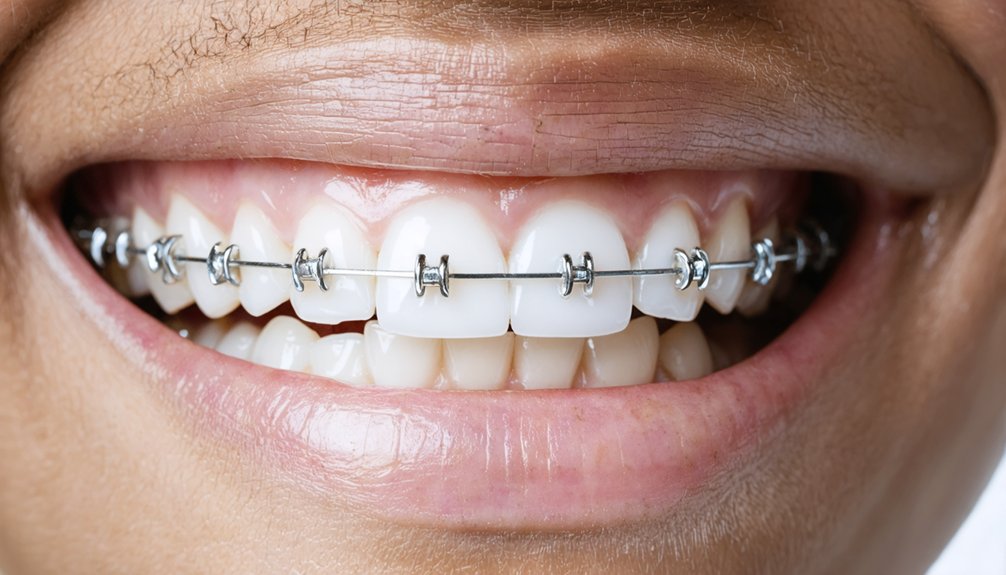
To maintain ideal tooth color throughout your orthodontic treatment, implementing a thorough care routine becomes essential. You’ll need to brush and floss consistently, using fluoride toothpaste to protect your enamel health.
Regular professional cleanings will address areas your daily routine can’t reach. Consider using antimicrobial or whitening mouthwash to combat surface stains, but avoid abrasive whitening products that could trigger tooth sensitivity.
You’ll want to minimize exposure to staining substances like coffee, red wine, and tobacco. After consuming acidic or sugary beverages, rinse with water immediately.
Include crunchy fruits and vegetables in your diet, as they naturally help clean your teeth. When using any whitening products, choose those containing fluoride and potassium nitrate to protect your enamel and reduce sensitivity while wearing braces.
Professional Recommendations for Timing Your Whitening Treatment
Since timing plays a crucial role in successful teeth whitening after braces, consulting with your orthodontist becomes necessary for developing an ideal treatment schedule.
Proper timing considerations protect your enamel health and guarantee optimal results. Your dental professional will assess your specific situation and recommend appropriate waiting periods.
- Wait 1-6 months after braces removal to allow gum inflammation to subside
- Let your enamel recover and strengthen through natural remineralization
- Choose gentler whitening products if starting treatment earlier (1-2 weeks post-removal)
- Consider using whitening toothpaste for minor stain management during the waiting period
- Schedule professional in-office treatments only after traditional braces are completely removed
Your orthodontist will evaluate your enamel condition and recommend the safest approach to achieve even, lasting results while minimizing sensitivity risks.
Common Mistakes to Avoid When Whitening With Braces
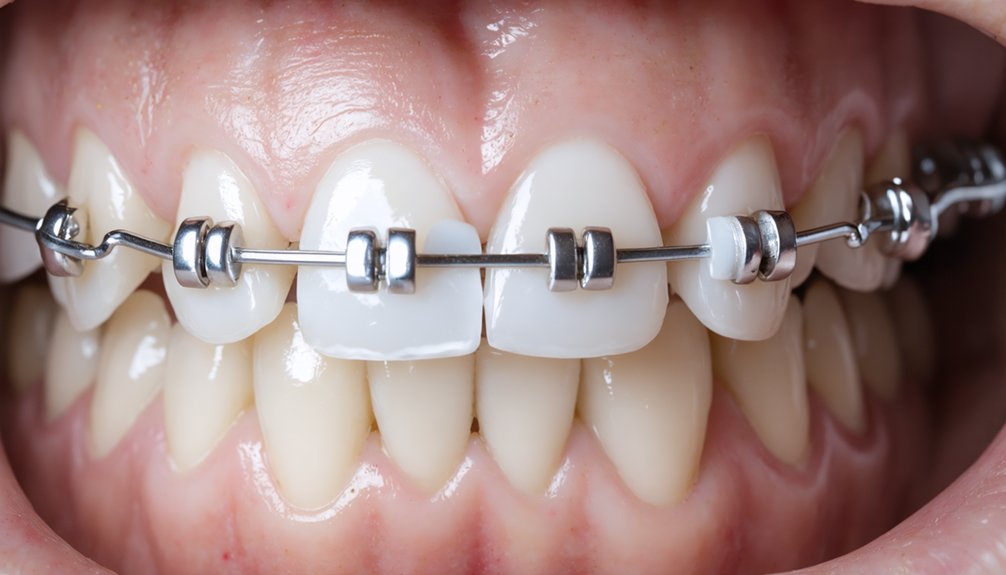
When using whitening strips with braces, you’ll need to be extremely careful about application technique to prevent uneven results and spots where the whitening agent pools around brackets.
You’re risking permanent discoloration and damage to your orthodontic work if you don’t first consult with your orthodontist about proper timing and product selection.
Skipping professional guidance can lead to compromised treatment outcomes, as your orthodontist needs to evaluate your specific case and recommend appropriate whitening options that won’t interfere with your braces.
Uneven Application Risks
Although whitening strips can be tempting to use with braces, improper application often leads to uneven results and potential complications.
When you’re wearing braces, achieving consistent whitening techniques becomes notably challenging due to bracket coverage and adhesion issues.
- Your teeth’s curved surfaces prevent whitening strips from making complete contact around brackets.
- Brackets block peroxide gel access to underlying enamel, creating patchy white spots.
- Strips can’t properly adhere due to orthodontic hardware, reducing their effectiveness.
- Dental restorations won’t respond to whitening, causing color mismatches.
- Plaque buildup around braces interferes with the whitening process.
Remember that professional guidance is essential, as improper application not only wastes product but can also damage your orthodontic appliances and irritate soft tissues, potentially extending your treatment time.
Skip Professional Consultation First
Skipping a professional dental consultation before whitening your teeth with braces can lead to serious complications and suboptimal results. Without proper dental evaluation, you’ll miss critical assessments of contraindications and potential risks specific to your oral health.
The consultation importance extends beyond basic safety concerns. Your dentist needs to evaluate whether specific whitening products are compatible with your braces, as some ingredients can damage brackets or cause metal oxidation.
They’ll also assess your enamel thickness and gum health to prevent sensitivity and irritation. Additionally, professional oversight guarantees early detection of adverse reactions and provides a tailored whitening strategy that prevents uneven results.
Special Considerations for Different Types of Braces
Since different types of braces present unique challenges for teeth whitening, you’ll need to understand the specific considerations for each orthodontic appliance.
When evaluating your options, consider these key factors for various braces types:
- Traditional metal and ceramic braces considerations include potential uneven whitening and limited strip contact with tooth surfaces.
- Lingual braces tips focus on the advantage of behind-the-teeth positioning, allowing better frontal whitening opportunities.
- Clear aligners offer the most flexibility since you can remove them before applying whitening strips.
- Both ceramic and metal braces require special attention to avoid damaging brackets or orthodontic glue.
- Alternative whitening methods, such as specialized toothpaste and mouthwash, may work better for fixed braces wearers.
Remember to maintain consistent oral hygiene practices regardless of your chosen whitening method.
Product Selection Guide for Orthodontic Patients
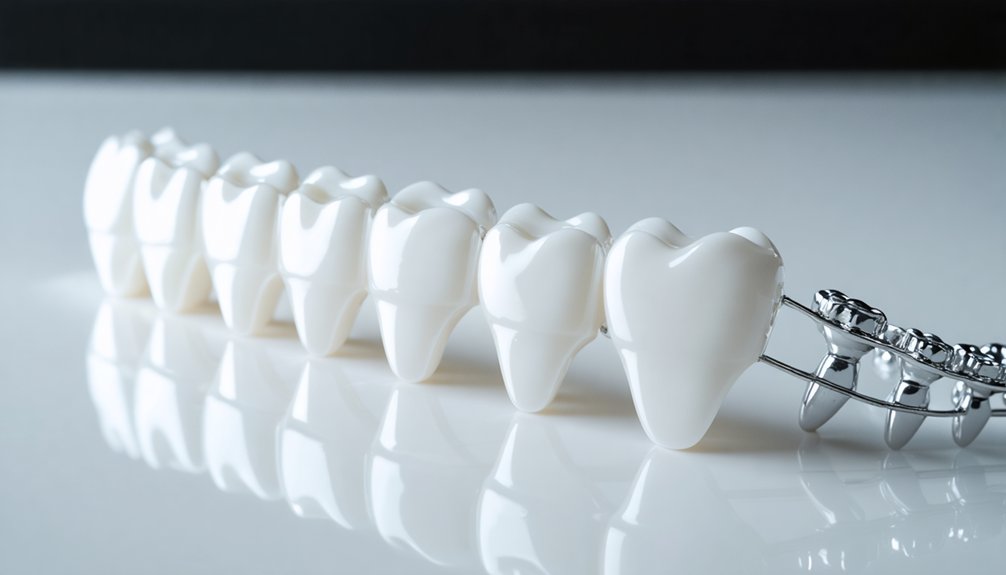
When you’re selecting whitening products while wearing braces, you’ll need to focus on ADA-approved options with lower peroxide concentrations to minimize sensitivity and gum irritation.
You should avoid strips containing harsh abrasives or acidic additives that could damage your orthodontic appliances or weaken the bracket adhesive.
Consider supplementing your whitening routine with braces-friendly products like specialized whitening toothpaste or alcohol-free mouth rinses that can help maintain results without compromising your orthodontic treatment.
Safe Whitening Product Options
Although many patients desire whiter teeth during orthodontic treatment, selecting appropriate whitening products requires careful consideration to prevent uneven results and potential damage to brackets.
For ideal whitening effectiveness and enamel safety, you’ll want to focus on products specifically formulated for orthodontic patients.
- Choose hydrogen peroxide-based toothpastes and rinses for gentle surface stain removal
- Consider peroxide-free natural whitening systems containing essential oils for gradual results
- Select products containing fluoride and potassium nitrate to minimize sensitivity
- Opt for specially designed whitening trays like Opalescence Go™ that work around brackets
- Avoid high-concentration peroxide strips or gels that can cause uneven whitening
Remember to consult your orthodontist before starting any whitening regimen, as they can recommend products tailored to your specific treatment plan and oral health needs.
Braces-Specific Brand Recommendations
While many whitening products claim to be safe for orthodontic patients, only a select few brands have proven effective for braces wearers.
SNOW Sensitive Dissolving Strips lead the market with their braces-specific design and impressive product efficacy, supported by positive user testimonials. If you’re seeking a peroxide-free option, consider Lumineux Teeth Whitening Strips, which offer gentle yet effective results for sensitive teeth.
Before selecting any whitening product, consult your orthodontist to verify it’s compatible with your specific type of braces.
While traditional metal braces require specialized products, you’ll find more flexibility with Invisalign or clear aligners.
When evaluating options, prioritize brands that offer customizable strips and non-abrasive formulas to protect your brackets and maintain even coloration throughout your orthodontic treatment.
Comparing Whitening Methods
Since orthodontic patients face unique challenges with teeth whitening, understanding the effectiveness and limitations of each method is essential for achieving ideal results.
When selecting whitening products during orthodontic care, consider these evidence-based comparisons:
- Whitening strips work effectively with clear aligners but aren’t recommended for traditional braces due to uneven coverage under brackets.
- Professional in-office treatments deliver potent results but may compromise bracket adhesion and create color inconsistencies.
- Electric toothbrushes with orthodontic heads provide safe mechanical stain removal without risking appliance damage.
- Whitening toothpaste and mouthwash offer gentle maintenance without compromising orthodontic materials.
- DIY methods like baking soda or peroxide mixtures pose risks to brackets and aren’t clinically proven safe for orthodontic patients.
Post-Treatment Whitening Strategies
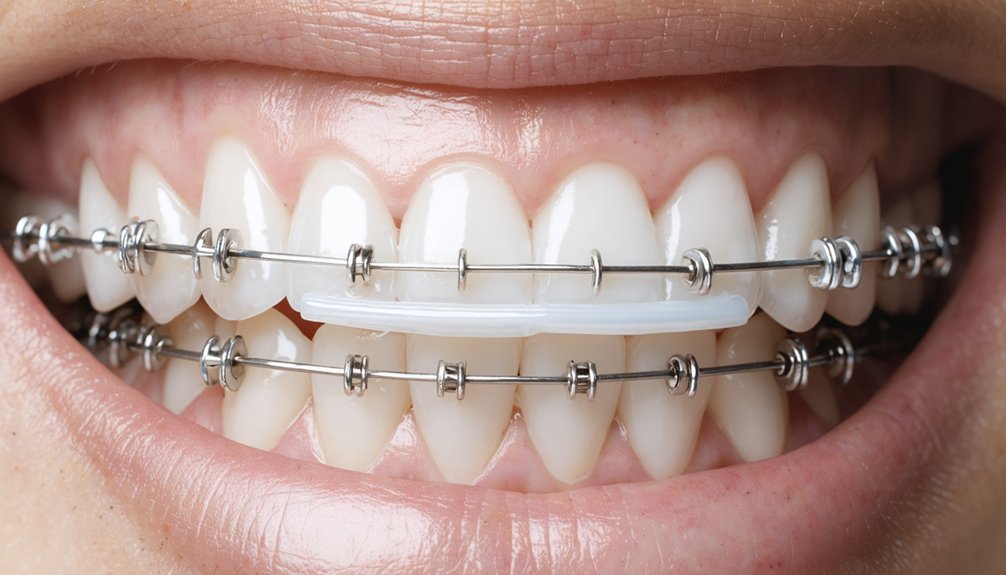
Getting your braces removed marks the perfect opportunity to enhance your smile through teeth whitening, but timing and proper preparation are essential for best results.
You’ll need to wait 4-6 weeks after braces removal to guarantee proper enamel stability before starting any whitening treatment.
Schedule a professional dental assessment to evaluate your enamel’s health and identify any post-braces issues like white spots or uneven discoloration. Your dentist may recommend pre-whitening fluoride treatments to strengthen your enamel and reduce sensitivity risks.
During this waiting period, maintain excellent oral hygiene to create ideal conditions for whitening success.
If you’re considering professional treatments, you’ll find they offer more uniform results than over-the-counter options, particularly for addressing bracket-related discoloration patterns common after braces removal.
Managing Expectations and Results During Orthodontic Care
Understanding what to expect during orthodontic care can help you make informed decisions about teeth whitening. During your braces adjustments, you’ll need to carefully manage your whitening timelines and expectations to achieve the best results.
- Consult your orthodontist before starting any whitening treatment, as certain types of braces aren’t compatible with whitening strips.
- Use whitening toothpaste and mouthwash as safe alternatives throughout your orthodontic treatment.
- Monitor tooth sensitivity closely, especially after braces adjustments.
- Consider postponing intensive whitening treatments until after braces removal to avoid uneven results.
- If you’re wearing Invisalign or lingual braces, you can proceed with whitening strips under professional guidance.
Remember that maintaining good oral hygiene during treatment will minimize staining and help you achieve better whitening results once your braces are removed.
Frequently Asked Questions
Can Whitening Strips Damage the Metal Wires on My Braces?
Yes, whitening strips can potentially oxidize and discolor your braces’ metal wires. For ideal braces maintenance and whitening safety, you shouldn’t use strips until your orthodontic treatment is complete.
How Long Should I Wait After Getting Braces Before Using Whitening Products?
With 98% of orthodontists advising against it, you shouldn’t use whitening products while wearing braces. Wait at least 6 months after removal for proper braces maintenance and ideal whitening timeline results.
Will Whitening Strips Affect the Color of My Rubber Bands?
You don’t need to worry about rubber band discoloration from whitening strips. They’re safe to use with your elastics since the peroxide agents don’t react with orthodontic materials, and you’ll change bands regularly anyway.
Can I Use Whitening Strips on Just the Visible Parts of My Teeth?
While 87% of orthodontists advise against targeted whitening, you shouldn’t use strips on visible areas only. This selective approach disrupts proper braces maintenance and creates noticeable color differences post-treatment.
Do Prescription-Strength Whitening Products Work Better With Braces Than Over-The-Counter Options?
You’ll get better whitening effectiveness with prescription products, but they still can’t reach under brackets. Their main benefits include stronger formulas and professional supervision for safer, more controlled treatment.
References
- https://crest.com/en-us/oral-care-tips/teeth-whitening/can-i-use-whitestrips-braces-retainer
- https://www.healthline.com/health/whitening-with-braces
- https://outstandingortho.com/whitening-your-teeth-with-braces-what-are-your-options/
- https://www.trysnow.com/blogs/news/can-you-use-teeth-whitening-strips-with-braces
- https://custercreekdental.com/tips-for-teeth-whitening-after-braces/
- https://www.briteorthodontics.com/braces/can-you-use-whitening-strips-with-braces/
- https://321orthodontics.com/blog/can-you-use-teeth-whitening-strips-with-braces/
- https://nvorthodontics.com/can-you-whiten-your-teeth-while-wearing-invisalign/
- https://classiccityorthodontics.com/teeth-whitening-while-wearing-aligners-is-it-safe/
- https://nw-ortho.com/at-home-care-and-hygiene/braces-and-teeth-whitening-what-you-need-to-know/
